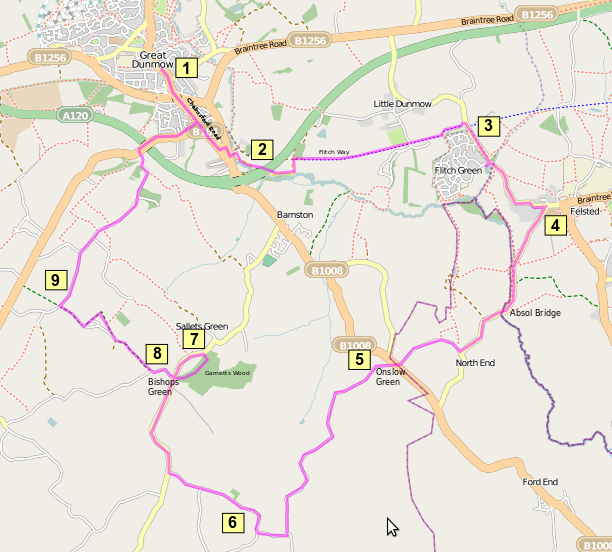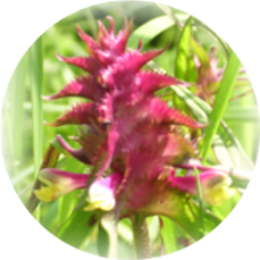Cycle Ride 3 – Great Dunmow and the Flitch Way
A route of about 13 miles from Great Dunmow, taking in part of the Flitch Way, a newly created nature area, a special roadside verge and an ancient woodland. Some off road sections. You should carry a good wildflower book, as well as the usual cycle repair kit, water and snacks. OS Map Sheet Landranger 167.

cycle Ride 3 map © OpenStreetMap contributors, CC-BY-SA
START at Point [1] From the centre of Great Dunmow taking Chelmsford Road eastwards. This can be a busy road, take care. At the foot of the hill and the curve round to the junction with the A130 bypass, try to turn into the service road to your right, and then look for a gap in the hedge on your left hand to a safer place to cross the A130. Cross the road and enter the track opposite, which carries a blue sign for the National Cycle route 16; you will be following this route for a while.
[2] The cycle route turns right into a field over a wooden plank bridge then left across the field to a concrete arch bridge over the River Chelmer. It is best to wheel your bike across this. You then join the Flitch Way following the track under the A120 flyover. This track can be potholed and very wet after rainy periods. Eventually it curves uphill and meets the line of the old railway between Great Dunmow and Braintree, where you turn right up a slope to the trackbed. The embankment here is covered with Primroses in the Spring, and they are also along the side of the old rail line. Continue eastwards on the old railway along this hedge lined track, with scattered wildflowers on the margins, and keep an eye open for birds in the hedges.
[3] Eventually the route turns to the left around a fenced area and reaches a tarmac road, curving to the left and meeting Station Road, Felsted. Turn right downhill passing the site of the former rail overbridge and continue straight on along the road (you leave the National Cycle route 16 at this point). On the right is a modern housing area, Flitch Green, and ignoring its first entrance, continue and turn into the second entrance and then immediately take the gravel path off to the left. This leads to a lake and a surrounding wildlife area created as part of
the housing development. You may see waterfowl on the lake, dragonflies, butterflies and woodland birds. Return to Station Road and continue in the direction you were travelling before into Felsted.
[4] At the triangular grassed junction in Felsted the route goes right, signposted to North End and Barnston. This is Mill Road. [ If you need to find a shop continue straight on at the junction into the village centre and then return to this point ]. Mill Road runs gently downhill and you reach the old watermill building on the right with its overhead loading gantry, and its attractive mill pond, again part of the River Chelmer. Continue on over Absol Bridge and then uphill into North End. At the village green with its pictorial information board and phone box bear right onto Bennetts Lane, signposted to Onslow Green.
[5] Continue on to meet the A130 and then taking care cross to the side road nearly opposite leading to Onslow Green. The green itself is a short distance along the lane and has a pond and a grassed area, which has some wildflower interest. Immediately past the green both verges are marked as Special Roadside Verges, and in Spring are good for Primrose and Cowslip, followed in midsummer by Red Campion, Crosswort, Yellow Archangel and other species.
[6] At the next junction ignore the turn to Pleshey and continue on, marked High Roding. Ignore the left turn to Stagsden Green and Pleshey and continue on, eventually reaching a T junction where you turn right signposted Dunmow. Continue on past the junction at Bishops Green soon reaching the entrance on the right to Garnetts Wood.
[7[ Here you will find a small picnic area with 2 timber benches. The wood itself is managed as coppice, felled at intervals of 10 to 20 years to produce timber poles. The coppice stools are Small Leaved Lime, a rare species of tree, which used to be very widespread in the days of the wildwood some thousands of years ago. In July they flower and the air is filled with the sound of bees visiting the flowers. The Spring sees the ground carpeted with Wood Anemone. You are not allowed to cycle in the wood, but taking the path that leads right from just inside the gateway and wheeling your bike walk along parallel to the wood edge. You will soon see where trees have been coppiced and protected by temporary fences. This is to protect the growing shoots from being eaten by deer. ( You will see few new shoots growing outside of these fences, and those that are trying are all eaten off or broken). It is an uncomfortable fact that the lack of predators in our modern countryside means that deer can breed unchecked until limited by starvation, and their food is our wildflowers and coppice regrowth. It has become a pressing modern problem, and if deer numbers are not controlled we will not have woodland wildlfowers nor young trees. The alternative to culling is to accept reintroduction of Wolves and Lynx.
[8] Returning to the road junction at Bishops Green take the side turning to High Roding. After a few hundred yards at a bend in the road look for a bridleway leading off to the right. Although this starts out a bit chewed up by horse hooves, and can be a bit muddy, it soon improves and becomes a well surfaced farm track. Continue to follow the track past the large House, Roffeys, turning left at the right angle bend and joining a tarmac surfaced road. Follow this road along to the crossroads.
[9] Turn right here and follow this quiet lane towards Great Dunmow, looking for Primroses on the verges in Spring. The original line of this lane has been severed by the new A120, and the lane now turns to make a junction with the B184. Turn right, and if the road is very busy perhaps use the pavement instead, passing over the A120 on a bridge into Great Dunmow. Carry straight on at the small roundabout, and then at the end of the road turn left and climb back up into the centre of Great Dunmow.
